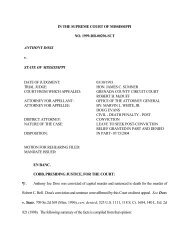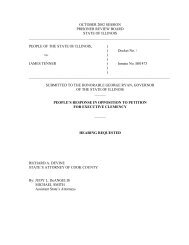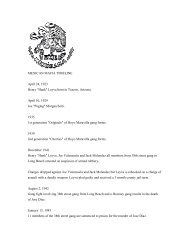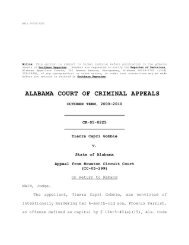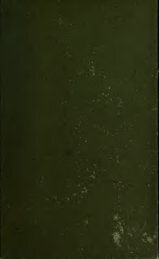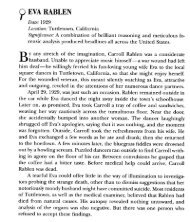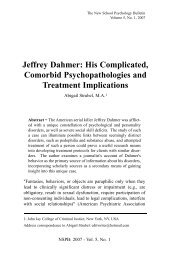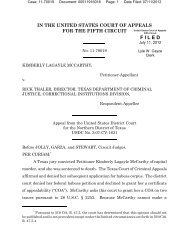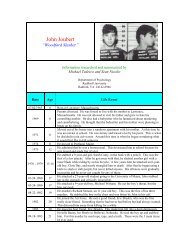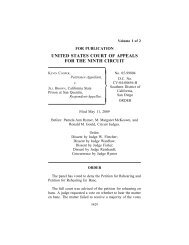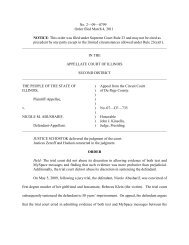Stacey Johnson v. State - Murderpedia, the encyclopedia of murderers
Stacey Johnson v. State - Murderpedia, the encyclopedia of murderers
Stacey Johnson v. State - Murderpedia, the encyclopedia of murderers
You also want an ePaper? Increase the reach of your titles
YUMPU automatically turns print PDFs into web optimized ePapers that Google loves.
SUPREME COURT OF ARKANSAS<br />
No. CR 05-1180<br />
STACEY EUGENE JOHNSON,<br />
APPELLANT,<br />
VS.<br />
STATE OF ARKANSAS,<br />
APPELLEE,<br />
Opinion Delivered May 18, 2006<br />
APPEAL FROM THE SEVIER COUNTY<br />
CIRCUIT COURT,<br />
NO. CR93-54,<br />
HON. TED C. CAPEHEART, JUDGE,<br />
AFFIRMED.<br />
JIM GUNTER, Associate Justice<br />
The issue in this case is whe<strong>the</strong>r <strong>the</strong> circuit court complied with this court’s mandate<br />
in <strong>Johnson</strong> v. <strong>State</strong>, 356 Ark. 534, 157 S.W.3d 151 (2004). We hold that it did comply and<br />
affirm <strong>the</strong> circuit court’s order.<br />
Appellant <strong>Stacey</strong> Eugene <strong>Johnson</strong> was convicted <strong>of</strong> capital murder in <strong>the</strong> death <strong>of</strong><br />
Carol Heath and was sentenced to death in 1994. We reversed <strong>the</strong> conviction because <strong>the</strong> trial<br />
court admitted a statement from <strong>the</strong> victim’s daughter identifying <strong>Johnson</strong>, after <strong>the</strong> daughter<br />
had been found incompetent to testify at trial. <strong>Johnson</strong> v. <strong>State</strong>, 326 Ark. 430, 934 S.W.2d<br />
179 (1996), cert. denied, 520 U.S. 1242 (1997) (<strong>Johnson</strong> I). In a second trial, <strong>Johnson</strong> was<br />
again convicted <strong>of</strong> capital murder and sentenced to death. We affirmed <strong>the</strong> conviction and<br />
sentence. See <strong>Johnson</strong> v. <strong>State</strong>, 342 Ark. 186, 27 S.W.3d 405 (2000), cert. denied, 532 U.S.<br />
944 (2001) (<strong>Johnson</strong> II).<br />
<strong>Johnson</strong> <strong>the</strong>n filed two petitions in <strong>the</strong> circuit court for postconviction relief: a Rule
37 petition, claiming ineffective assistance <strong>of</strong> counsel, and an Act 1780 petition for writ <strong>of</strong><br />
1<br />
habeas corpus, seeking to retest certain DNA evidence. The circuit court denied both<br />
petitions. On appeal, we affirmed <strong>the</strong> denial <strong>of</strong> relief on <strong>the</strong> Rule 37 petition, but reversed<br />
and remanded on one <strong>of</strong> <strong>Johnson</strong>’s claims in his Act 1780 petition. <strong>Johnson</strong> v. <strong>State</strong>, 356<br />
Ark. 534, 157 S.W.3d 151 (2004) (<strong>Johnson</strong> III). Specifically, we agreed with <strong>Johnson</strong> that<br />
certain negroid hairs introduced into evidence should be retested. Id. at 564, 157 S.W.3d at<br />
173. Relying on DNA test results indicating that <strong>the</strong> probability that <strong>the</strong> hairs belonged to<br />
ano<strong>the</strong>r African American was only 1 in 250, we held that because this ratio included so<br />
many persons o<strong>the</strong>r than <strong>Johnson</strong>, he was entitled to retest <strong>the</strong>se hairs. Id. at 550, 157 S.W.3d<br />
at 163.<br />
On remand, <strong>the</strong> circuit court did not order retesting <strong>of</strong> <strong>the</strong> negroid hairs, but instead<br />
entered an order finding that <strong>the</strong> <strong>State</strong> had complied with our requirement that <strong>the</strong> hairs be<br />
retested because <strong>the</strong> hairs had been retested in preparation for <strong>the</strong> second trial in 1997. Under<br />
<strong>the</strong> new test, <strong>the</strong> DNA pr<strong>of</strong>ile matched that <strong>of</strong> <strong>Johnson</strong> and decreased <strong>the</strong> likelihood from 1<br />
in 250 to 1 in 720 million that <strong>the</strong> hairs belonged to an African American o<strong>the</strong>r than <strong>Johnson</strong>.<br />
The circuit court denied <strong>Johnson</strong>’s Act 1780 new-trial request. <strong>Johnson</strong> appeals from that<br />
order.<br />
<strong>Johnson</strong>’s sole point on appeal is that <strong>the</strong> trial court erred in denying him <strong>the</strong> right to<br />
1The<br />
version <strong>of</strong> Act 1780 <strong>of</strong> 2001 that is relevant to this appeal is codified at Ark.<br />
Code Ann. § 16-112-201 through § 16-112-207 (Supp. 2003).<br />
2
have <strong>the</strong> negroid hairs retested upon remand from <strong>Johnson</strong> III. Specifically, he argues that<br />
our mandate required <strong>the</strong> circuit court to retest <strong>the</strong> hairs and that <strong>the</strong> circuit court had no<br />
discretion to deny retesting. We affirm.<br />
A brief factual history regarding <strong>the</strong> evidence at issue in <strong>Johnson</strong> III is helpful to<br />
explain <strong>the</strong> issue in this appeal. In <strong>Johnson</strong> III, <strong>Johnson</strong> argued, among o<strong>the</strong>r things, that <strong>the</strong><br />
circuit court erred in denying his Act 1780 petition seeking retesting <strong>of</strong> DNA evidence from<br />
saliva found on a cigarette butt and from certain negroid hairs. We denied his claim with<br />
regard to <strong>the</strong> cigarette butt, but agreed with <strong>Johnson</strong> that <strong>the</strong> negroid hairs should be retested.<br />
We remanded to <strong>the</strong> trial court to order retesting.<br />
We described this evidence and <strong>the</strong> tests performed on it as follows:<br />
DNA test evidence was presented at both trials on <strong>the</strong> cigarette butt and<br />
negroid hairs, and <strong>Johnson</strong> was not able to be excluded as <strong>the</strong> donor <strong>of</strong> <strong>the</strong><br />
DNA. According to Kermit Channell <strong>of</strong> <strong>the</strong> Arkansas Crime Laboratory, <strong>the</strong><br />
chances <strong>the</strong> DNA belonged to ano<strong>the</strong>r African American was 1 in 250.<br />
Sometime after <strong>the</strong> first trial, fur<strong>the</strong>r testing was performed on <strong>the</strong> saliva on <strong>the</strong><br />
cigarette butt and it was shown that <strong>Johnson</strong> still was not excluded as <strong>the</strong><br />
donor and <strong>the</strong> probability that ano<strong>the</strong>r African American was <strong>the</strong> donor <strong>of</strong> <strong>the</strong><br />
DNA was decreased from 1 in 250 to 1 in 28 million. In o<strong>the</strong>r words, retesting<br />
actually made it more likely that it was <strong>Johnson</strong>'s DNA on <strong>the</strong> cigarette butt.<br />
The negroid hairs were not retested.<br />
Id. at 543, 157 S.W.3d at 159 (emphasis added).<br />
In denying <strong>Johnson</strong>’s request for a retest <strong>of</strong> <strong>the</strong> cigarette butt, we reasoned that <strong>the</strong><br />
cigarette butt had already been retested once, and that, “[f]ar from excluding Mr. <strong>Johnson</strong>,<br />
<strong>the</strong> probability <strong>of</strong> <strong>the</strong> saliva being a donor o<strong>the</strong>r than Mr. <strong>Johnson</strong> went from 1 in 250 to 1<br />
in 28 million, <strong>the</strong>reby decreasing <strong>the</strong> probability that <strong>the</strong> saliva belonged to anyone o<strong>the</strong>r than<br />
3
Mr. <strong>Johnson</strong>.” Id. at 549, 157 S.W.3d at 162-63. We agreed with <strong>the</strong> trial court that <strong>Johnson</strong><br />
was seeking an endless succession <strong>of</strong> retesting <strong>of</strong> old evidence, stating that<br />
Id.<br />
Act 1780 was not meant to do away with finality in judgments. It was meant<br />
to be used to test evidence that will prove actual innocence <strong>of</strong> a wronglyconvicted<br />
person. It is conceivable that one could test and retest evidence<br />
repeatedly, each time obtaining a more narrow result, while <strong>the</strong>re is still a<br />
“<strong>the</strong>oretical possibility” that at some point a retest would exclude a defendant.<br />
Where would it end?<br />
In granting <strong>Johnson</strong>’s request to retest <strong>the</strong> negroid hairs, we stated as follows:<br />
The test results on <strong>the</strong> negroid hairs presented at trial are much more<br />
troubling. At trial, DNA results on <strong>the</strong>se hairs could not exclude Mr. <strong>Johnson</strong>,<br />
but <strong>the</strong> probability that <strong>the</strong>y belonged to ano<strong>the</strong>r African-American were only<br />
1 in 250. Considering <strong>the</strong> population <strong>of</strong> African-Americans in Arkansas alone,<br />
<strong>the</strong>se results could conceivably include hundreds or thousands <strong>of</strong> people<br />
besides Mr. <strong>Johnson</strong>. Mr. <strong>Johnson</strong> acknowledges that retesting could result in<br />
<strong>the</strong> same narrowing <strong>of</strong> probability that happened when <strong>the</strong> cigarette butt was<br />
retested, but that <strong>the</strong> 1 in 250 ratio is so broad and includes so many persons<br />
o<strong>the</strong>r than Mr. <strong>Johnson</strong>, that he is entitled to retesting <strong>of</strong> <strong>the</strong> negroid hairs<br />
under Act 1780. We agree that retesting <strong>of</strong> <strong>the</strong> negroid hairs could be<br />
materially relevant to Mr. <strong>Johnson</strong>'s claim <strong>of</strong> innocence. . . .<br />
For <strong>the</strong>se reasons, we reverse <strong>the</strong> trial court's denial <strong>of</strong> Mr. <strong>Johnson</strong>'s Act 1780<br />
petition for retesting <strong>of</strong> <strong>the</strong> negroid hairs and remand for <strong>the</strong> trial court to have<br />
such tests conducted.<br />
Id. at 550-51, 157 S.W.3d at 163-64.<br />
The <strong>State</strong> contends, and <strong>the</strong> circuit court found, that our opinion in <strong>Johnson</strong> III<br />
contained a factual error. We stated in <strong>Johnson</strong> III that <strong>the</strong> DNA test results indicated that<br />
<strong>the</strong> probability <strong>the</strong> DNA from <strong>the</strong> negroid hairs belonged to ano<strong>the</strong>r African American<br />
besides <strong>Johnson</strong> was 1 in 250; we also stated that <strong>the</strong> negroid hairs had not been retested after<br />
4
this finding. See <strong>Johnson</strong> III, supra. After examination <strong>of</strong> <strong>the</strong> record, we believe that this<br />
statement was incorrect.<br />
The 1 in 250 probability resulted from a test conducted in February 1994 before <strong>the</strong><br />
first trial. The negroid hairs were tested three more times after <strong>the</strong> first trial. Melisa Weber,<br />
a DNA analyst with Cellmark Diagnostics who performed all <strong>of</strong> <strong>the</strong> DNA tests, testified in<br />
<strong>the</strong> second trial that five tests were performed on <strong>the</strong> negroid hairs. While <strong>the</strong> second test<br />
conducted in 1994 resulted in a ratio <strong>of</strong> 1:250, <strong>the</strong> final test, described in a June 18, 1997,<br />
report, stated that <strong>the</strong> statistical frequency distribution <strong>of</strong> <strong>the</strong> genetic material – that is, <strong>the</strong><br />
negroid hairs – belonging to someone o<strong>the</strong>r than <strong>the</strong> appellant came to 1:720 million in <strong>the</strong><br />
African-American population. The court regrets its factual error, but it does not affect our<br />
holding in <strong>Johnson</strong> III.<br />
“mandate” is<br />
The issue before this court is whe<strong>the</strong>r <strong>the</strong> circuit court complied with <strong>the</strong> mandate. A<br />
<strong>the</strong> <strong>of</strong>ficial notice <strong>of</strong> action <strong>of</strong> <strong>the</strong> appellate court, directed to <strong>the</strong> court below,<br />
advising that court <strong>of</strong> <strong>the</strong> action taken by <strong>the</strong> appellate court, and directing <strong>the</strong><br />
lower court to have <strong>the</strong> appellate court’s judgment duly recognized, obeyed,<br />
and executed.<br />
City <strong>of</strong> Dover v. Barton, 342 Ark. 521, 525, 29 S.W.3d 698, 700 (2000) (quoting Dolphin v.<br />
Wilson, 335 Ark. 113, 983 S.W.2d 113 (1998)).<br />
In Dolphin, we adopted <strong>the</strong> Third Circuit Court <strong>of</strong> Appeals’ rules regarding mandates,<br />
stating that “[t]his fundamental rule binds every court to honor rulings in <strong>the</strong> case by superior<br />
courts. . . . [A]n inferior court has no power or authority to deviate from <strong>the</strong> mandate issued<br />
5
y an appellate court. . . . A trial court must implement both <strong>the</strong> letter and spirit <strong>of</strong> <strong>the</strong><br />
mandate, taking into account <strong>the</strong> appellate court’s opinion and <strong>the</strong> circumstances it<br />
embraces.” Dolphin, 335 Ark. at 118, 983 S.W.2d at 114 (quoting Casey v. Planned<br />
Parenthood, 14 F.3d 848, 857 (3d Cir. 1994)).<br />
Where a remand limits <strong>the</strong> issues for determination, <strong>the</strong> court on remand is<br />
precluded from considering o<strong>the</strong>r issues, or new matters, affecting <strong>the</strong> cause.<br />
. . . Similarly, when a case is remanded for a specific act, <strong>the</strong> entire case is not<br />
reopened, but ra<strong>the</strong>r <strong>the</strong> lower tribunal is only authorized to carry out <strong>the</strong><br />
appellate court’s mandate, and <strong>the</strong> trial court may be powerless to undertake<br />
any proceedings beyond those specified.<br />
Any proceedings on remand which are contrary to <strong>the</strong> directions contained in<br />
<strong>the</strong> mandate from <strong>the</strong> appellate court may be considered null and void.<br />
City <strong>of</strong> Dover, 342 Ark. at 526, 29 S.W.3d at 700 (internal citations omitted).<br />
Our mandate in <strong>Johnson</strong> III states as follows:<br />
This case was submitted to <strong>the</strong> Arkansas Supreme Court on <strong>the</strong> record <strong>of</strong> <strong>the</strong><br />
Circuit Court <strong>of</strong> Sevier County and briefs <strong>of</strong> <strong>the</strong> respective parties. After due<br />
consideration, it is <strong>the</strong> decision <strong>of</strong> <strong>the</strong> Court that <strong>the</strong> case be affirmed in part;<br />
reversed and remanded in part for <strong>the</strong> reasons set out in <strong>the</strong> attached opinion.<br />
Special Justice Barbara Webb joins. Corbin, J., not participating.<br />
This mandate remands “for <strong>the</strong> reasons set out in <strong>the</strong> attached opinion.” Our law requires <strong>the</strong><br />
trial court to implement both <strong>the</strong> letter and spirit <strong>of</strong> <strong>the</strong> mandate, taking into account <strong>the</strong><br />
appellate court’s opinion and <strong>the</strong> circumstances it embraces. See Dolphin, supra. The court<br />
may not reopen <strong>the</strong> case to consider o<strong>the</strong>r issues or matters not included in <strong>the</strong> mandate. See<br />
City <strong>of</strong> Dover, supra.<br />
In this case, <strong>the</strong> circuit court complied with <strong>the</strong> mandate. It did not reopen <strong>the</strong> case or<br />
consider any issues o<strong>the</strong>r than a retest <strong>of</strong> <strong>the</strong> negroid hairs. Our decision in <strong>Johnson</strong> III was<br />
6
concerned with whe<strong>the</strong>r a retest was required under Act 1780, not whe<strong>the</strong>r it had been<br />
conducted. While we did order retesting <strong>of</strong> <strong>the</strong> negroid hairs in <strong>Johnson</strong> III, we did so<br />
because we were troubled by <strong>the</strong> ratio <strong>of</strong> 1/250. We stated that <strong>the</strong> “1 in 250 ratio is so broad<br />
and includes so many persons o<strong>the</strong>r than Mr. <strong>Johnson</strong> that he is entitled to retesting[.]” Id.<br />
at 550, 157 S.W.3d at 163. What we made clear in <strong>Johnson</strong> III is that <strong>the</strong> point <strong>of</strong> error in this<br />
case is <strong>the</strong> point at which <strong>the</strong> DNA test indicated a probability ratio <strong>of</strong> 1 in 250. The trial<br />
court correctly found that <strong>the</strong> negroid hairs were retested after this point <strong>of</strong> error. In fact, <strong>the</strong>y<br />
were retested three times. The final DNA test <strong>of</strong> <strong>the</strong> negroid hairs indicated a statistical<br />
frequency distribution that <strong>the</strong> genetic material belonged to someone in <strong>the</strong> African-<br />
American population o<strong>the</strong>r than <strong>the</strong> appellant was 1 in 720 million. We hold that <strong>the</strong> circuit<br />
court complied with <strong>the</strong> letter and spirit <strong>of</strong> our mandate in <strong>Johnson</strong> III. Ano<strong>the</strong>r retest is not<br />
necessary.<br />
Affirmed.<br />
IMBER, J., dissents.<br />
CORBIN, J., not participating.<br />
ANNABELLE CLINTON IMBER, Justice, dissenting. A “mandate” is <strong>the</strong> <strong>of</strong>ficial notice<br />
<strong>of</strong> action <strong>of</strong> <strong>the</strong> appellate court, directed to <strong>the</strong> court below, advising that court <strong>of</strong> <strong>the</strong> action<br />
taken by <strong>the</strong> appellate court, and directing <strong>the</strong> lower court to have <strong>the</strong> appellate court’s<br />
judgment duly recognized, obeyed, and executed. Dolphin v. Wilson, 335 Ark. 113, 983<br />
S.W.2d 113 (1998) (citing 5 Am. Jur. 2d § 776). “[A]n inferior court has no power or<br />
7
authority to deviate from <strong>the</strong> mandate issued by an appellate court.” Briggs v. Penn. R. Co.,<br />
334 U.S. 304, 306 (1948). Moreover, <strong>the</strong> matters decided upon one appeal become <strong>the</strong> law<br />
<strong>of</strong> <strong>the</strong> case and govern this court upon a second appeal, even though we might be inclined<br />
to say that we were wrong in <strong>the</strong> first instance. Wilson v. Rodgers, 256 Ark. 276, 507 S.W.2d<br />
508 (1974).<br />
In <strong>Johnson</strong> v. <strong>State</strong>, 356 Ark. 535, 57 S.W.3d 151 (2004) (<strong>Johnson</strong> III), our court<br />
concluded that <strong>the</strong> DNA results on <strong>the</strong> negroid hairs could not exclude Mr. <strong>Johnson</strong> and that<br />
<strong>the</strong> probability <strong>of</strong> ano<strong>the</strong>r African-American being <strong>the</strong> donor <strong>of</strong> <strong>the</strong> DNA in question was 1<br />
2<br />
in 250. With regard to DNA results on <strong>the</strong> negroid hairs, we issued <strong>the</strong> following mandate<br />
and order to <strong>the</strong> circuit court:<br />
The negroid hairs. The test results on <strong>the</strong> negroid hairs presented at trial are<br />
much more troubling. At trial, DNA results on <strong>the</strong>se hairs could not exclude<br />
Mr. <strong>Johnson</strong>, but <strong>the</strong> probability that <strong>the</strong>y belonged to ano<strong>the</strong>r African-<br />
American were only 1 in 250. Considering <strong>the</strong> population <strong>of</strong> African-<br />
Americans in Arkansas alone, <strong>the</strong>se results could conceivably include<br />
hundreds or thousands <strong>of</strong> people besides Mr. <strong>Johnson</strong>. Mr. <strong>Johnson</strong><br />
acknowledges that retesting could result in <strong>the</strong> same narrowing <strong>of</strong> probability<br />
that happened when <strong>the</strong> cigarette butt was retested, but that <strong>the</strong> 1 in 250 ratio<br />
is so broad and includes so many persons o<strong>the</strong>r than Mr. <strong>Johnson</strong>, that he is<br />
entitled to retesting <strong>of</strong> <strong>the</strong> negroid hairs under Act 1780. We agree that<br />
2<br />
Our opinion in <strong>the</strong> direct appeal, <strong>Johnson</strong> v. <strong>State</strong>, 342 Ark. 186, 192, 27 S.W.3d<br />
405, 409 (2000) (<strong>Johnson</strong> II), reflects <strong>the</strong> same conclusion. Not until <strong>the</strong> petition for<br />
rehearing in <strong>Johnson</strong> III did <strong>the</strong> <strong>State</strong> challenge <strong>the</strong> accuracy <strong>of</strong> that conclusion.<br />
Moreover, <strong>the</strong> <strong>State</strong> now concedes that its statements in <strong>the</strong> earlier petition for rehearing<br />
“incorrectly characterized negroid hairs submitted to Cellmark by <strong>the</strong> state crime lab.”<br />
The <strong>State</strong>’s valiant attempt to clarify which hairs were tested and retested, as well as <strong>the</strong><br />
findings from those tests, only serves to confirm that <strong>the</strong> record itself is difficult to<br />
decipher.<br />
8
etesting <strong>of</strong> <strong>the</strong> negroid hairs could be materially relevant to Mr. <strong>Johnson</strong>’s<br />
claim <strong>of</strong> innocence. Certainly, <strong>the</strong> o<strong>the</strong>r evidence in this trial shows that a<br />
favorable result would not per se exonerate Mr. <strong>Johnson</strong>. None<strong>the</strong>less, our<br />
interpretation <strong>of</strong> § 16-112-202 does not require such a showing <strong>of</strong> complete<br />
exoneration in order to request retesting alone. The fact that some <strong>of</strong> <strong>the</strong><br />
negroid hairs were found on <strong>the</strong> victim’s body made <strong>the</strong>m particularly relevant<br />
to <strong>the</strong> prosecution’s case, and test results that would exclude Mr. <strong>Johnson</strong><br />
could significantly advance his claim <strong>of</strong> innocence. For <strong>the</strong>se reasons, we<br />
reverse <strong>the</strong> trial court’s denial <strong>of</strong> Mr. <strong>Johnson</strong>’s Act 1780 petition for retesting<br />
<strong>of</strong> <strong>the</strong> negroid hairs and remand for <strong>the</strong> trial court to have such tests<br />
conducted.<br />
<strong>Johnson</strong> III, 356 Ark. at 550-551, 157 S.W.3d at 163-164 (emphasis added).<br />
On remand, <strong>the</strong> circuit court did not order retesting <strong>of</strong> <strong>the</strong> negroid hairs; ra<strong>the</strong>r, <strong>the</strong><br />
court went behind this court’s mandate and determined that <strong>the</strong> <strong>State</strong> had previously retested<br />
<strong>the</strong> hairs. In fact, <strong>the</strong> circuit court simply concluded that our holding was erroneous.<br />
Whe<strong>the</strong>r or not this court erred in <strong>Johnson</strong> III, <strong>the</strong> circuit court was obligated to comply with<br />
our mandate to have <strong>the</strong> negroid hairs retested. Moreover, our court does not now have <strong>the</strong><br />
authority to determine that we were previously wrong in ordering <strong>the</strong> circuit court to retest<br />
<strong>the</strong> negroid hairs. Wilson v. Rodgers, supra. The only relevant inquiry is whe<strong>the</strong>r <strong>the</strong> circuit<br />
court complied with our previous mandate – and it clearly did not.<br />
Consequently, it is beyond me how <strong>the</strong> majority is able to conclude that an action that<br />
so blatantly flies against <strong>the</strong> court’s holding in <strong>Johnson</strong> III complies with <strong>the</strong> “letter and spirit<br />
<strong>of</strong> our mandate.” The majority opinion is nothing more than a disguised recall <strong>of</strong> our<br />
mandate in <strong>Johnson</strong> III for <strong>the</strong> purpose <strong>of</strong> declaring error. In effect, <strong>the</strong> majority goes behind<br />
<strong>the</strong> opinion in <strong>Johnson</strong> III to declare that <strong>Johnson</strong> III contains a factual error. The majority<br />
9
<strong>the</strong>n suggests that <strong>the</strong> factual error does not affect our holding in <strong>Johnson</strong> III. Yet, in<br />
<strong>Johnson</strong> III we reversed <strong>the</strong> trial court’s denial <strong>of</strong> Mr. <strong>Johnson</strong>’s petition for retesting <strong>of</strong> <strong>the</strong><br />
negroid hairs and remanded for <strong>the</strong> trial court to have such tests conducted. As <strong>of</strong> today,<br />
however, <strong>the</strong> trial court’s order denying Mr. <strong>Johnson</strong>’s petition for retesting is affirmed.<br />
For <strong>the</strong> above-stated reasons, I respectfully dissent.<br />
10



